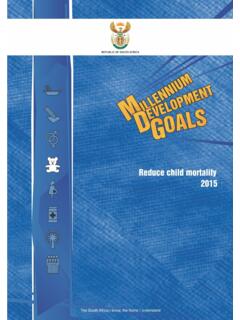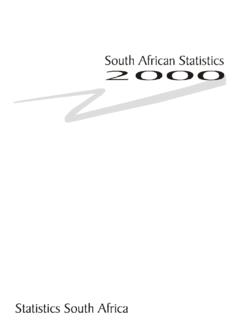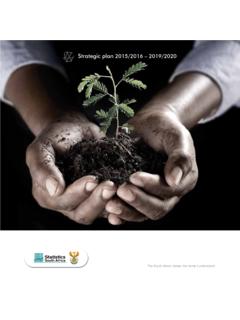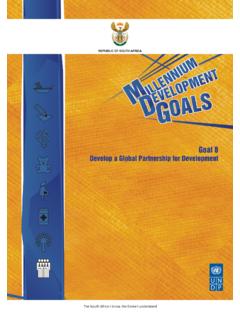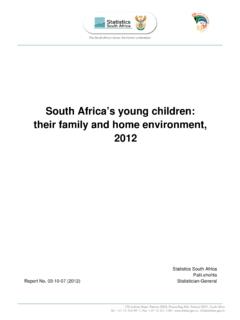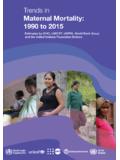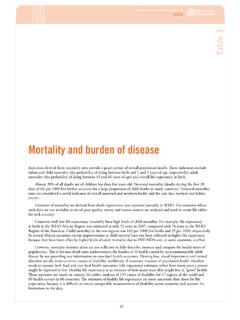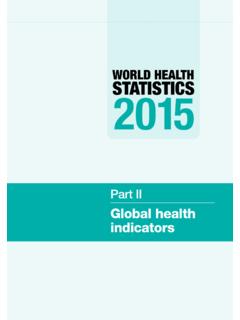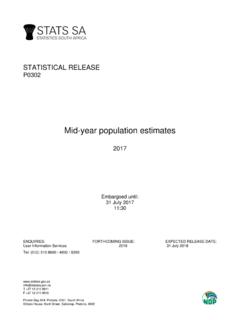Transcription of Mid-year population estimates
1 Statistical release P0302 Mid-year population estimates2015 Embargoed until:23 July 2015 10:00 Enquiries: Forthcoming issue: Expected release date User Information Services Mid-year population estimates , 2016 July 2016 Tel: 012 310 8600/4892/8390 Statistics South Africa P0302 Mid-year population estimates , 2015 iiContents Summary .. 1 1. Introduction .. 3 2. Demographic and other assumptions .. 3 3. Demographic and other indicators .. 5 4. National population 7 5. Provincial population estimates .
2 10 Demographic assumptions .. 10 Provincial distributions .. 12 Migration patterns .. 12 Provincial estimates by age and sex .. 12 References .. 17 Tables Table 1: Mid-year population estimates for South Africa by population group and sex, 2015 .. 2 Table 2: Mid-year population estimates by province, 2015 .. 2 Table 3: Assumptions of expectation of life at birth without AIDS and fertility .. 4 Table 4: International migration assumptions for the period 1985 2015 .. 4 Table 5: Demographic indicators, 2002 2015 .. 5 Table 6: Births and deaths for the period 2002 2015.
3 6 Table 7: HIV prevalence estimates and the number of people living with HIV, 2002 7 Table 8: Mid-year estimates by population group and sex, 2015 .. 7 Table 9: Estimated annual population growth rates, 2002 2015 .. 8 Table 10: Mid-year population estimates by population group, age and sex, 2015 .. 9 Table 11: Percentage distribution of the projected provincial share of the total population , 2002 2015 .. 12 Table 12: Estimated provincial migration streams, 2001 2006 .. 13 Table 13: Estimated provincial migration streams, 2006 2011 .. 13 Table 14: Estimated provincial migration streams, 2011 2016.
4 14 Table 15: Provincial population estimates by age and sex, 2015 .. 15 Figures Figure 1: Provincial average total fertility rate .. 10 Figure 2: Provincial average life expectancy at birth (males) .. 11 Figure 3: Provincial average life expectancy at birth (females) .. 11 Statistics South Africa P0302 Mid-year population estimates , 2015 1 Summary This release uses the cohort-component methodology to estimate the 2015 Mid-year population of South Africa. The estimates cover all the residents of South Africa at the 2015 Mid-year , and are based on the latest available information.
5 estimates may change as new data become available. For 2015, Statistics South Africa (Stats SA) estimates the Mid-year population as 54,96 million. Approximately fifty-one per cent (approximately 28,07 million) of the population is female. Gauteng comprises the largest share of the South African population . Approximately 13,20 million people (24%) live in this province. KwaZulu-Natal is the province with the second largest population , with 10,92 million people (19,9%) living in this province. With a population of approximately 1,19 million people (2,2%), Northern Cape remains the province with the smallest share of the South African population .
6 About 30,2% of the population is aged younger than 15 years and approximately 8,0% (4,42 million) is 60 years or older. Of those younger than 15 years, approximately 22,9% (3,80 million) live in KwaZulu-Natal and 19,7% (3,28 million) live in Gauteng. Of those elderly aged 60 years and older, the highest percentage 26,3% (1,16 million) reside in Gauteng. The proportion of elderly persons aged 60 and older is increasing over time. Migration is an important demographic process in shaping the age structure and distribution of the provincial population .
7 For the period 2011 2016 it is estimated that approximately 243 118 people will migrate from the Eastern Cape; Limpopo is estimated to experience an out-migration of nearly 303 151 people. During the same period, Gauteng and Western Cape are estimated to experience an inflow of migrants of approximately 1 169 837 and 350 569 respectively (see migration stream tables for net migration). Life expectancy at birth for 2015 is estimated at 60,6 years for males and 64,3 years for females. The infant mortality rate for 2015 is estimated at 34,4 per 1 000 live births.
8 The estimated overall HIV prevalence rate is approximately 11,2% of the total South African population . The total number of people living with HIV is estimated at approximately 6,19 million in 2015. For adults aged 15 49 years, an estimated 16,6% of the population is HIV positive. Statistics South Africa P0302 Mid-year population estimates , 2015 2 Table 1: Mid-year population estimates for South Africa by population group and sex, 2015 population group Male Female Total Number % Number % Number % African 21 653 500 80,6 22 574 500 80,4 44 228 000 80,5 Coloured 2 334 800 8,7 2 498 100 8,9 4 832 900 8,8 Indian/Asian 688 100 2,6 673 900 2,4 1 362 000 2,5 White 2 201 900 8,2 2 332 200 8,3 4 534 000 8,3 Total 26 878 300 100,0 28 078 700 100,0 54 956 900 100,0 Table 2.
9 Mid-year population estimates by province, 2015 population estimate % of total population Eastern Cape 6 916 200 12,6 Free State 2 817 900 5,1 Gauteng 13 200 300 24,0 KwaZulu-Natal 10 919 100 19,9 Limpopo 5 726 800 10,4 Mpumalanga 4 283 900 7,8 Northern Cape 1 185 600 2,2 North West 3 707 000 6,7 Western Cape 6 200 100 11,3 Total 54 956 900 100,0 PJ Lehohla Statistician-General Statistics South Africa P0302 Mid-year population estimates , 2015 31.
10 Introduction In a projection, the size and composition of the future population of an entity such as South Africa is estimated. The Mid-year population estimates produced by Statistics South Africa (Stats SA) use the cohort-component method. In the cohort-component method, a base population is estimated that is consistent with known demographic characteristics of the country. The cohort base population is projected into the future according to the projected components of change. Agreed levels of fertility, mortality and migration are used as input to the cohort-component method.
